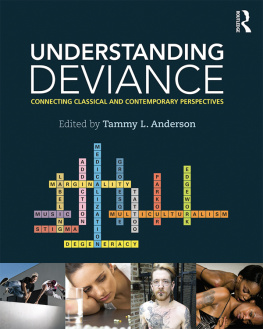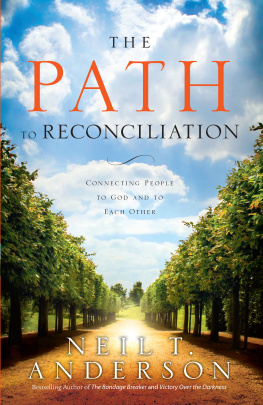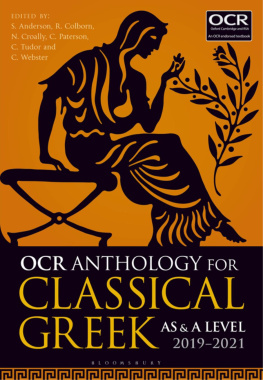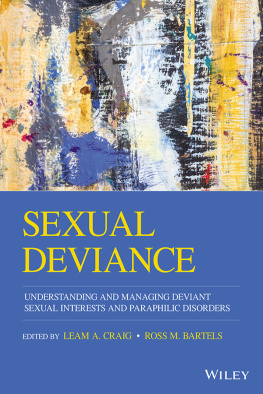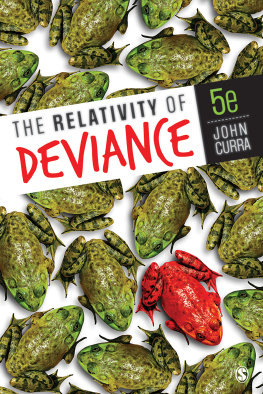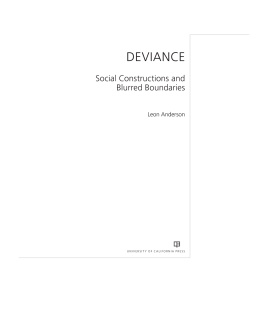Tammy L. Anderson - Understanding deviance : connecting classical and contemporary perspectives
Here you can read online Tammy L. Anderson - Understanding deviance : connecting classical and contemporary perspectives full text of the book (entire story) in english for free. Download pdf and epub, get meaning, cover and reviews about this ebook. year: 2014, publisher: Routledge, genre: Politics. Description of the work, (preface) as well as reviews are available. Best literature library LitArk.com created for fans of good reading and offers a wide selection of genres:
Romance novel
Science fiction
Adventure
Detective
Science
History
Home and family
Prose
Art
Politics
Computer
Non-fiction
Religion
Business
Children
Humor
Choose a favorite category and find really read worthwhile books. Enjoy immersion in the world of imagination, feel the emotions of the characters or learn something new for yourself, make an fascinating discovery.
- Book:Understanding deviance : connecting classical and contemporary perspectives
- Author:
- Publisher:Routledge
- Genre:
- Year:2014
- Rating:5 / 5
- Favourites:Add to favourites
- Your mark:
- 100
- 1
- 2
- 3
- 4
- 5
Understanding deviance : connecting classical and contemporary perspectives: summary, description and annotation
We offer to read an annotation, description, summary or preface (depends on what the author of the book "Understanding deviance : connecting classical and contemporary perspectives" wrote himself). If you haven't found the necessary information about the book — write in the comments, we will try to find it.
Understanding deviance : connecting classical and contemporary perspectives — read online for free the complete book (whole text) full work
Below is the text of the book, divided by pages. System saving the place of the last page read, allows you to conveniently read the book "Understanding deviance : connecting classical and contemporary perspectives" online for free, without having to search again every time where you left off. Put a bookmark, and you can go to the page where you finished reading at any time.
Font size:
Interval:
Bookmark:
by Charles F. Andrain
by Robert Nash Parker and Emily K. Asencio
by Ronald J. Berger
by James C. Witte and Susan E. Mannon
by Lara Descartes and Conrad Kottak
by Bernard McGrane and John Gunderson
by Douglas Brownridge
by Barbara G. Brents, Crystal A. Jackson, and Kate Hausbeck
by Thomas J. Linneman
by Sarah Fenstermaker and Nikki Jones
by Eve Shapiro
by Ronald Berger
by Michelle Berger and Cheryl Radeloff
by Kerry Ferris and Scott Harris
by Phillip Vannini, Dennis Waskul, and Simon Gottschalk
by Sheldon Ekland-Olson
by Jacqueline Adams
by Layli Maparyan
by Wesley Longhofer and Daniel Winchester
by Melissa Wilcox
by Sheldon Ekland-Olson
by Tammy L. Anderson

www.routledge.com/cw/anderson
by Routledge
711 Third Avenue, New York, NY 10017
2 Park Square, Milton Park, Abingdon, Oxon OX14 4RN
Understanding deviance : connecting classical and contemporary pieces / edited by Tammy L. Anderson.
ISBN: 978-0-415-64261-3 (pbk)
ISBN: 978-1-315-87963-5 (ebk)
by Apex CoVantage, LLC
Defining Deviance
Font size:
Interval:
Bookmark:
Similar books «Understanding deviance : connecting classical and contemporary perspectives»
Look at similar books to Understanding deviance : connecting classical and contemporary perspectives. We have selected literature similar in name and meaning in the hope of providing readers with more options to find new, interesting, not yet read works.
Discussion, reviews of the book Understanding deviance : connecting classical and contemporary perspectives and just readers' own opinions. Leave your comments, write what you think about the work, its meaning or the main characters. Specify what exactly you liked and what you didn't like, and why you think so.

